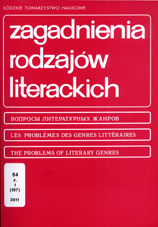Niesamowite, słowiańszczyzna, Zagłada. O „Pomalowanym ptaku” Jerzego Kosińskiego (architeksty i parateksty). Część pierwsza
Das Uncheimliche, Slavdom, Holocaust. On "The Painted Bird"' by Jerzy Kosinski (Paratexts and Architexts). Part Il.
Author(s): Danuta SzajnertSubject(s): Literary Texts
Published by: Łódzkie Towarzystwo Naukowe
Summary/Abstract: In this part of my text I propose a thesis, that in The Painted Bird presented world is crucially molded by the grotesque pattern, which bares nature of reality as a place evoking repugnance. Next I consider comic element of horriblegrotesque (J. Ruskin) mixed in special way with the horrified and the uncanny (in Freud's interpretation). I made it clear however, that - like in the cases of architexts (genre patterns) described before - we cannot about grotesque in this novel without allowance for ironic or modality which shaped it. Grotesque deformation induces us to treating The Painted Bird as an anti- fairy-tale. We can also reagard "orientalisation" (E. Said) of the novel peasants as grotesque one. Kosinski uses parable, "ethnographic mask of evil" (M. Janion), grotesque, metaphor, naturalistic and symbolic theatricalization of violence and cruelty to stimulate the imaginary of his readers. He wants to touch them, to shake them because, as he confesses in his paratexts, he does not believe history to have such power itself. That's the reason he tells us his story. The story based on the substitution, neither on competition with fact-collecting historical narrative nor with fact-collecting literature of private testimony. The Painted Bird doesn'trank among the classical titles of Holocaust literature, but it presents an important statement about this subject.
Journal: Zagadnienia Rodzajów Literackich
- Issue Year: 54/2011
- Issue No: 1
- Page Range: 69-109
- Page Count: 41
- Language: Polish

